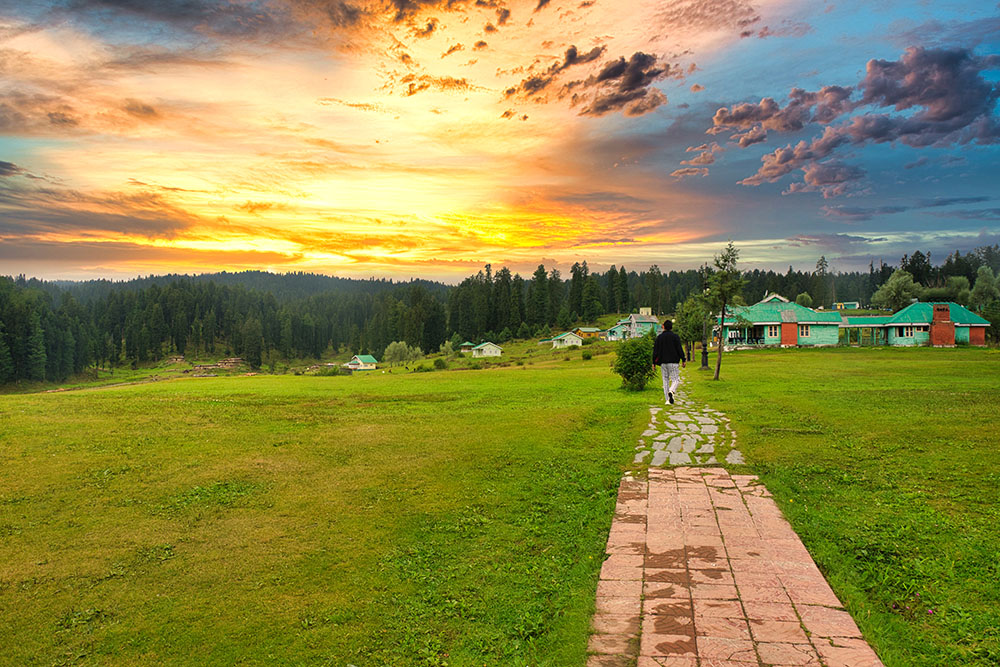
If I knew this, I would be God: Our guide to us when we asked him if he thought it would rain the next day.
You are our guest. We can not let you go unguided in the forest: The tourism officer to us when we said we could manage by ourselves on the forest trek.
Sir, this is a horse from Yusmarg, not Gulmarg: A little boy insisting we sit on his horse.
Our visit to Yusmarg was filled with such profound wisdom; we were surrounded by people who cared more about our safety than we did, and the tourism economy of Yusmarg was explained to us in a single line, by a little horseman.
Other than that it was the usual in Kashmir living in a wooden cottage on a flower-filled meadow, waking up to golden sunrises, walking through pine forests, crossing river streams, and being invited by a nomad family to take their family portrait.
Yusmarg to Srinagar is a mere 50 km drive of a couple of hours. Largely, tours to Kashmir allow one day for sightseeing in Yusmarg.
No, Yusmarg should not be as a day trip from Srinagar. May we present the case for a longer stay in Yusmarg?

That was our home in Yusmarg. This cottage accommodation is run by the Jammu and Kashmir Tourism Department.

We could see the golden sunrise from the window of our cottage.




Set up a picnic anywhere, sipping your tea in the company of horses and flowers. Relax, take a deep breath and enjoy the moment. Ample of opportunity to spend time with yourself and be lost in thought.



Do you notice a common theme in these pictures of Yusmarg?
Unlike the more popular destinations like Gulmarg and Sonmarg, people are conspicuously absent from Yusmarg. There might be a few local or “day” tourists. But other than a few hours in the day, the entire Yusmarg meadows will be all your to explore and enjoy. Countryside Kashmir
There are many places to explore around the Yusmarg meadows, at a walking distance. Doodhganga is a gushing stream, a few minutes down the Yusmarg meadows.
For a more soaking activity, head to the lake Nilnag. Walk through the village Gojipathri as you walk towards Nilnag. Carry a packed lunch or some filling snacks as you head here. Set up a nice little picnic, and cool yourself around the blue waters of Nilnag.

Head back through the forest route. Birds, flowers, butterflies, wildlife (?), the forest route had more to offer to a curious traveler. This forest walk is part of the trail to Chadora. Yusmarg to Chadora is a one day trek, preferably done with a local guide. Stay for the night at Chadora (or return via the road to Yusmarg).
If you ask the people of Kashmir, they might say just a few hours walk. But bear in mind, they are different than us, city folks. Unless you have fitness like this, ask them for an estimated time at your pace!

Every direction you go, there is a 1-2 day trekking option around Yusmarg. The tourism officer has complied a rough sketch of these trekking routes and their directions which is put up in his office. When we told him we had come to Yusmarg to prepare for the Amarnath yatra, he discussed the various possibilities with us. And arranged for a guide to take us on a suitable trek.

We went up the forest to the meadows of Dragdolan. Our guide told us there was a Dragdolan 1 and 2. Depending on our interest, he would decide how far to go. When we weren’t satiated even after reaching the second point, he took us ahead to a point called Barga. We walked a total of 25 km that day, a perfect workout to prepare us for the multiple day climbs of the Amarnath yatra.

Soon we were among the nomadic settlements of the Gujjars.


At a distance, we heard a woman call out to our guide. She was asking if we wanted to have “doodh ki roti” (flatbreads made of milk). We had never heard of it before, so decided to give it a try.

In we walked into their Gujjar hut. Reluctant to barge in into someones home like that, we stood at the door. But the women would have none of it. They asked us to wait inside as they made the rotis.

They then charged us a measly ten rupees for a roti. Then refilled our water bottles with water they had walked miles to fetch (without accepting any money for it). And let our guide have his hukkah break using their hukkah.
On our way back, they called out to us again. This time, the entire family was home from the forest, for lunch. They wanted us to take a proper family portrait.

A few days later, walking down the markets of Pahalgam, we saw the same roti being sold for a price over ten times higher in a “plush” restaurant. No amount of plus would, however, match the Gujjar family's hut, high up in the mountains!
Other than the Gujjars, we met a very few people along the way. There was one guy carrying his sick sheep to a medical camp up in Yusmarg. Lack of local medical facilities meant they had to walk for hours to reach the nearest health care center. For the animals (who are the lifeline for people living up in the Himalayas), they had to wait for the medical camps that would be set up every few weeks in Yusmarg.
